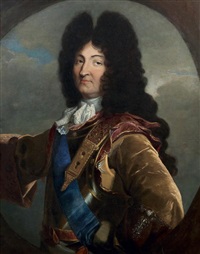The long, flowing hair that Louis XIV had in his early years became the ideal for a wig. Unfortunately, the Sun King was prone to baldness and used wigs to cover up the increasing number of bald spots. Consequently, the periwig became all the rage amongst his male courtiers - Charles II of England was another big fan of the periwig ensuring its popularity in England as well.
Thus, the periwig re-entered the fashionable circles in 1660 and already in 1665 it was considered an absolute necessary part of a gentleman's attire.
A periwig had to have curls or at least waves. By the 1670's the style favoured was long rows of cork-screw curls and by the 1690's the periwig would rise high above the wearer's head and would often be parted in the middle.
 |
| A periwig made from horsehair which happens to be in a terrible state |
The style of the periwig changed to and fro over the decades. At some point it became fashionable to powder it more white which would later be transferred to other types of wigs. The styling aside, periwigs for the upper classes were made of human hair. The hair used for the wigs could be collected from a wide array of "donors": novices entering a convent had their hair cut for example. It became a symbol of power to have a "natural" wig compared to those made of goat or dog hair.
Cardinal Mazarin was concerned about the expense of importing hair and attempted to turn the court towards "domestic goods". However, he soon gave up when he discovered that the expense was equalled by French trade.
It was rather unfortunate that the wigs had a tendency to emit an unpleasant odour; that they were never washed but pomaded and powdered did not help. To combat the smell the wigs were often scented with flowers.
With Louis XIV's dependency on wigs for his illustrious appearance it is no wonder that the artistry of wig-making flourished during his reign. Rumour has it that the King had forty wig-makers in his personal employ; it is more certain that he issued a decree naming them artists. The odd thing was that his courtiers were so eager to follow their master's fashion that they often had their heads shaved even if they were equipped with a full head of hair.
 |
| The style favoured by soldiers due to practicality |
The fashion was not merely confined to the upper classes and the trend quickly spread. However, it was not always practical to have long and luscious hair tumbling over one's shoulders. Soldiers and sportsmen were annoyed by the style and tied their locks at the nape; this did only became acceptable elsewhere after 1710.
As stated, the periwig became less popular after 1715 when Louis XIV died. The periwig would still be used in formal instances and some professions - such as lawyers and financiers - used it as a part of their working uniform. Although the periwig became less popular it did not quite disappear but was seldom used in the latter part of the 18th century.
 |
| Louis XIV wearing a dark periwig |
 |
| The Grand Dauphin wearing a powdered periwig |
 |
| Mansart with the characteristic wig which has been parted in the middle |
 |
| A whole array of powdered periwigs |
 |
| A perfect example of a late 17th century periwig |

Great.
ReplyDeleteThank you for the resource! It was an interesting read, and it's good to have some historical context and dates on when this style of wig went out of fashion.
ReplyDelete